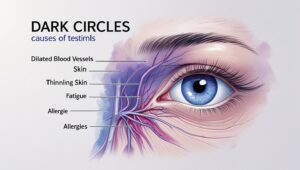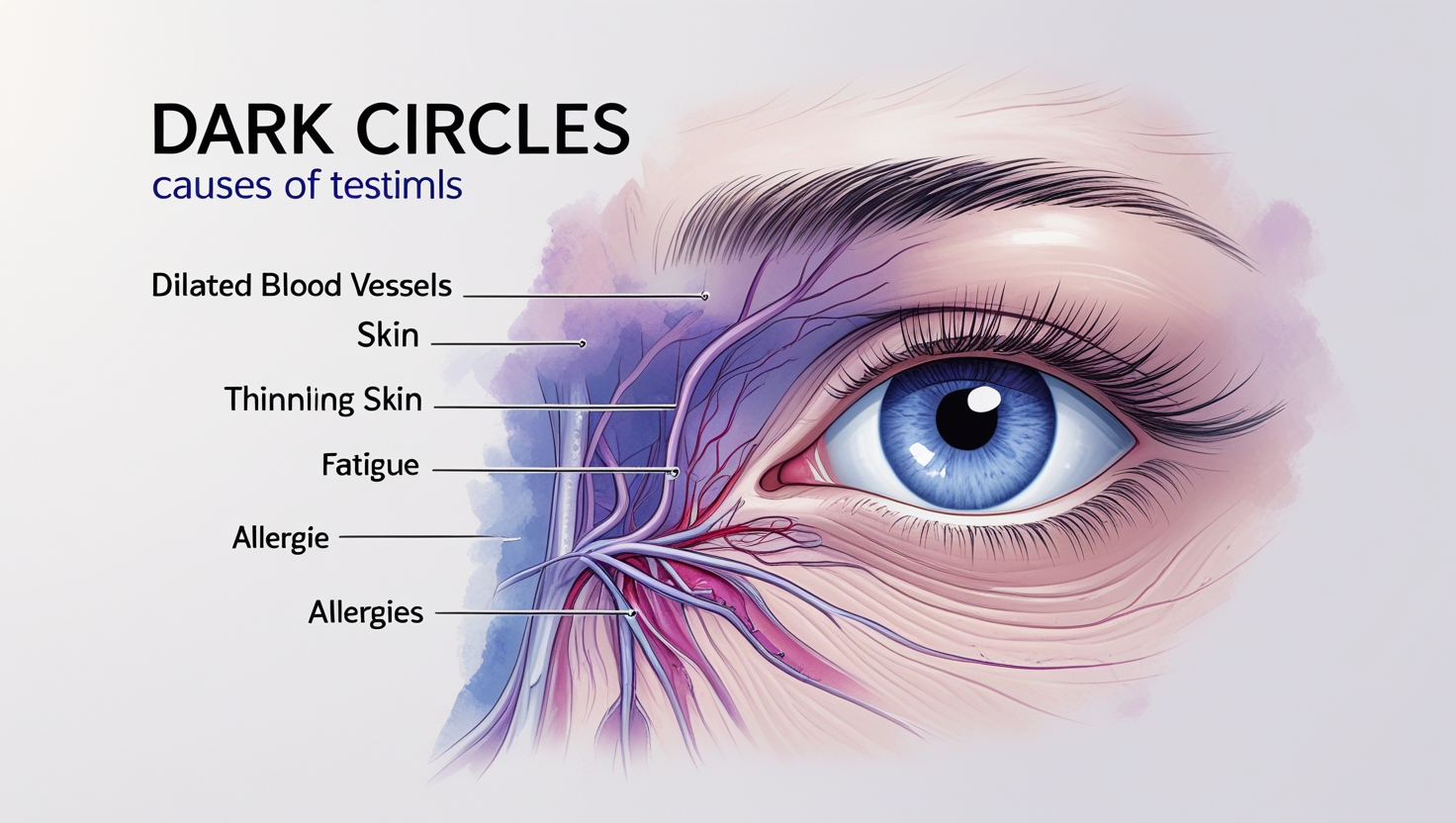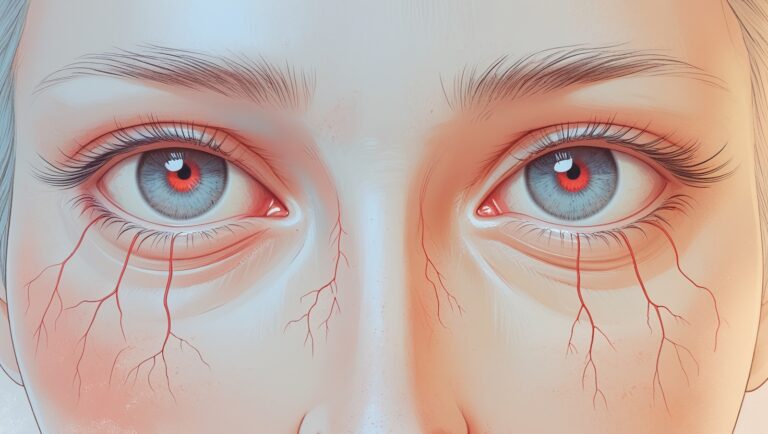Table of Contents
- Introduction
- What Are Dark Circles?
- Common Causes of Dark Circles
- Types of Dark Circles and What They Indicate
- Are Dark Circles a Health Concern?
- Real-Life Scenarios: What’s Causing Yours?
- How to Get Rid of Dark Circles
- Prevention Tips to Avoid Dark Circles
- Expert-Backed Tips for Brighter Eyes
- Myths About Dark Circles Debunked
- When to See a Doctor or Dermatologist
- Conclusion and Next Steps
1. Introduction
Ever look in the mirror and feel like you look tired, even after a good night’s sleep? You’re not alone. Dark circles under the eyes are one of the most common beauty complaints. They can make you look exhausted, older, or even unwell—but are they really something to worry about?
In this 2025 expert guide, we’ll break down everything you need to know about dark circles: what causes them, what they really mean, and most importantly, what you can do to reduce or prevent them.
2. What Are Dark Circles?
Dark circles refer to the darker skin that appears under your lower eyelids. They can be:
- Blue, purple, brown, or black in tone
- Accompanied by puffiness or bags
- Temporary or chronic
Understanding the underlying cause is the first step toward effective treatment.
3. Common Causes of Dark Circles
Lack of Sleep
Sleep deprivation is a leading cause. When you don’t rest enough:
- Blood vessels dilate
- Skin appears paler
- Dark tissue and blood become more visible under the skin
Genetics and Family History
Sometimes, it’s just in your genes. If your parents have dark circles, you’re more likely to have them too.
Aging and Thinning Skin
As we age:
- Skin loses collagen and becomes thinner
- Blood vessels become more visible
- Fat under the eye may shift, deepening shadows
Allergies and Sinus Problems
Congestion from allergies causes:
- Swollen blood vessels
- Poor drainage around the eyes
- Inflammation and fluid buildup
Dehydration
Lack of hydration causes:
- Skin to appear dull and sunken
- Eye area to look shadowed
Eye Strain from Screens
Increased screen time in 2025 strains your eyes, enlarging the blood vessels and making dark circles more pronounced.
Sun Exposure
UV rays increase melanin production, especially in thin-skinned areas like under the eyes.
Lifestyle Factors
- Smoking: Depletes oxygen and collagen
- Alcohol: Causes dehydration and dilated blood vessels
- Poor diet: Lack of vitamins can thin skin and worsen shadows
4. Types of Dark Circles and What They Indicate
Blue or Purple Hues
- Usually due to thin skin revealing blood vessels
- Often genetic or from fatigue
Brown or Hyperpigmented Circles
- Caused by excess melanin or sun exposure
- More common in darker skin tones
Puffy or Shadowed Circles
- Result from under-eye bags or loss of fat
- Common with aging and sleep issues
5. Are Dark Circles a Health Concern?
Usually, no. But in some cases, they can signal:
- Anemia
- Chronic fatigue syndrome
- Thyroid conditions
- Kidney issues (especially if paired with puffiness)
If dark circles are new, worsening, or paired with other symptoms, see a healthcare provider.
6. Real-Life Scenarios: What’s Causing Yours?
You’re a Night Owl
- Late nights and early mornings? Likely sleep-related.
You Work Long Hours on a Screen
- Consider digital eye strain.
Your Parents Have Them Too
- Genetics could be the key factor.
You Tan Easily or Skip Sunscreen
- Hyperpigmentation from sun exposure is likely.
7. How to Get Rid of Dark Circles
Home Remedies
- Cold compresses: Reduce swelling and shrink vessels
- Cucumber slices: Cool and hydrate skin
- Tea bags (green or black): Contain caffeine and antioxidants
- Aloe vera gel: Soothes and moisturizes
Over-the-Counter Products
Look for ingredients like:
- Vitamin C: Brightens and boosts collagen
- Retinol: Thickens skin and reduces discoloration
- Caffeine: Reduces puffiness and constricts blood vessels
- Hyaluronic acid: Deep hydration
Medical and Cosmetic Treatments
- Chemical peels: Lighten pigmentation
- Laser therapy: Reduces pigmentation and vascular shadows
- Fillers: Address volume loss and under-eye hollows
- Microneedling or PRP therapy: Boost collagen production
Lifestyle Changes
- Get 7–9 hours of sleep
- Reduce screen time
- Hydrate consistently
- Wear sunscreen daily
- Eat a balanced, antioxidant-rich diet
8. Prevention Tips to Avoid Dark Circles
- Apply SPF around eyes daily
- Wear blue-light blocking glasses
- Use a silk pillowcase to reduce friction
- Avoid rubbing your eyes
- Quit smoking and limit alcohol
- Sleep with your head elevated to reduce fluid pooling
9. Expert-Backed Tips for Brighter Eyes
- Use a cooling roller or jade stone in the morning
- Apply eye creams with peptides or niacinamide
- Limit salt intake to reduce water retention
- Don’t skip your sunglasses—UV rays damage delicate eye skin
10. Myths About Dark Circles Debunked
- “Only tired people get dark circles.” Not true—many causes exist.
- “Drinking more water alone will fix them.” Helpful, but not a cure-all.
- “Eye creams don’t work.” Some do—if they have the right ingredients.
- “They’re only a cosmetic issue.” Sometimes, they reflect health problems.
11. When to See a Doctor or Dermatologist
You should consult a professional if:
- Circles appear suddenly
- They get worse over time
- They’re accompanied by other symptoms
- You suspect an underlying health condition
- Home or OTC treatments aren’t working
12. Conclusion and Next Steps
Dark circles under the eyes can be frustrating, but they’re often treatable and preventable. Whether they’re caused by genetics, lifestyle, or health factors, the key is to understand the root cause and apply the right remedy.
Your Next Steps:
- Start tracking your sleep, hydration, and screen time
- Use products with proven ingredients
- Talk to a dermatologist if needed
- Don’t be discouraged—consistent care yields results
Bright, refreshed eyes are within your reach. Start today by making small changes that add up to visible results!
Visit for more :- Greakstive
External References & Further Reading:
- Dark Circles Under The Eyes: Causes & Treatment
- What Causes Dark Circles Under Your Eyes?
- Dark circles under eyes Causes







